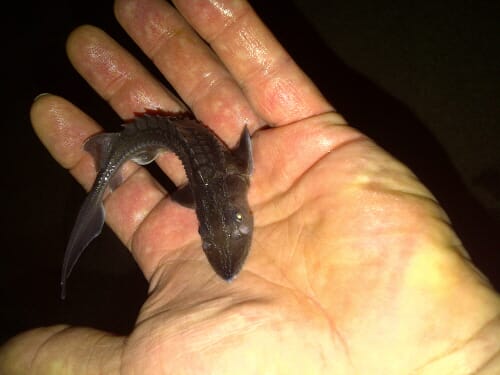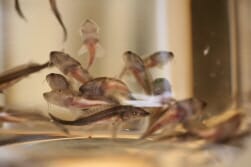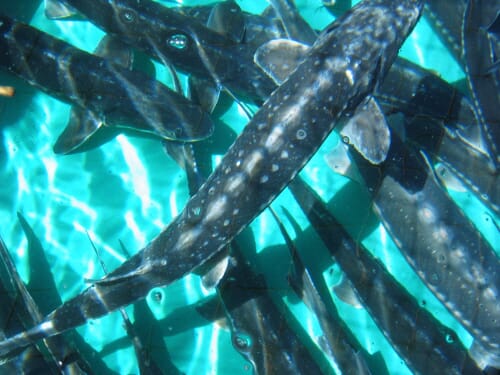
World sturgeon supply has been falling since the early 1990s. Whilst supply of wild sturgeon has historically come from the Caspian Sea, since around the time of the collapse of the USSR, control of fisheries in this area has been lost. Overfishing and poaching has meant that stocks have seriously diminished.
Reports state that stocks of Beluga sturgeon, which is considered to produce the highest quality caviar, have fallen 95 per cent over the last 20 years.
There are around 26 species of sturgeon, all in the Northern hemisphere, the majority of which are now endangered.
Having previously produced a number of species, including black cod, salmon and trout, on land and in salt water, Target Marine Hatcheries was presented with the opportunity of producing white sturgeon in 1999.
White sturgeon can be found in the Fraser Valley, British Colmbia. A while back, the University of Vancouver Island began collecting sturgeon from the Fraser River, for educational purposes. In 1999, the University donated a handful of broodstock to the farm, in order for them to focus on rearing and increasing stock numbers of white sturgeon.
Mr Henry said the juveniles given by the University were from a second spawning. In 2000, the first white sturgeon eggs came onto the farm.
"White sturgeon are quite different to other species of fish. Eggs hatch after six days of fertilisation, resulting in very immature fry. This presents a number of challenges when culturing sturgeon," he said.
A lot of research is being carried out, at the University of Vancouver Island and on site, looking at increasing fry and fingerling survival, optimal feeding regimes and feed presentation.
Mortality rates from hatch can be as high 50 per cent, and half of this stock can again be lost when the fingerlings are introduced onto feed. Recent research has successfully achieved a 90 per cent survival rate for one batch of finglerlings from hatch to feed, a significant progression, which Mr Henry hopes will continue.

Target Marine has been experimenting with the feed fed to young fish, in order to stimulate their appetite. Mr Henry said the group is still working on refining this diet, but that larval, krill and other live feeds have all been used.
The company has also been carrying out feed trials on smaller and larger fish, to see how different environments and feed types will affect the quality, size, taste, texture and colour of the caviar.
Once the young fish are fairly well established, they are left to grow for a couple of years, until they reach between 5-10 kg. This is when they can be sexed, said Mr Henry.
To date there is no simple method to sex sturgeon. Each fish must be surgically opened, and organs identified. Recently some farms have been experimenting with ultrasound, and in some farms in Russia, expertise has allowed ultrasound tests to be the sole method of identification.
Males are harvested as soon as they are sexed (between 5-10kg). This sturgeon meat is then harvested to high end restaurants.

Females return to the tanks and remain there until they are mature.
In the wild, age of maturity depends upon the surrounding environment. For example, Mr Henry said that sturgeon in the upper Fraser River may not mature until 35 years. However in the lower Fraser River, where the water is warmer, and there is a larger abundance of food, sturgeon may mature at 15 years.
Mr Henry says that the Fraser River white sturgeon reared in captivity have proven different - maturing at 11 years old. This proves just how flexible these fish are, says Mr Henry. With the right water quality and feed, time to maturity can be shortened.
"The majority of these females will be harvested for caviar, however we will keep a few back for reproduction," said Mr Henry.
True caviar is taken from pre-ovulated eggs, Mr Henry explains, and this is what the demand is for. So in practice, the sturgeon is killed, her ovaries are taken out, and then the rest of the fish will be sold for meat and by-products.
Once harvested from the fish, the eggs are submerged in cold water for cleaning. Mr Henry says that from a biopsy of a sturgeon's ovary taken recently, Target Marine is expecting high quality caviar and large eggs.
Due to the time is takes for the sturgeon to mature, Mr Henry says that some countries are looking at taking ovulated eggs. However, it can be harder to collect and clean the eggs once they have been laid.
In the wild, females produce between one to three million eggs, and spawn every three to four years. They have been known to live over 100 years.
Caviar
It has taken a long time to produce this caviar, said Mr Henry. It is expected that the caviar will be harvested in two months, and that is when Target Marine will find out the true value of their product.
"We will be marketing the product as high quality caviar, to global markets such as the US, Asia and Europe as well as in Canada."
Sturgeon usually yield around eight per cent caviar, said Mr Henry. So a 50 kg sturgeon would produce 4 kg of caviar.

Sturgeon meat
Demand for sturgeon meat is growing steadily, he said. Target Marine are slowly building up cliental, selling meat at the local markets in Vancouver. He says there is high demand for the meat from overseas. The dense white meat has a high value abroad, even in the US, Mr Henry says.
A smoked sturgeon product is something that could be developed soon.
To date sturgeon are sent off site to be slaughtered, however Target Marine hope to be able to harvest the caviar on site in the near future. The site is currently in discussions with the local district to get permission to process the fish on the farm.
Mr Henry said that there is huge public support for the proposal to process the sturgeon on the farm.
"It's not that the district is reluctant to allow new development, as it will be a great benefit to the community. However there are about 12 people who are opposed to the idea."
After this first batch of sturgeon, due to be harvested in the next few months, it will be nearly another year, before Target Marines can harvest any more caviar.
In the older generation of fish on the farm, there are 2000 sturgeon that will be ready to sort in August.
Concluding Mr Henry said that he is very much looking forward to launching the product in the next few months.

